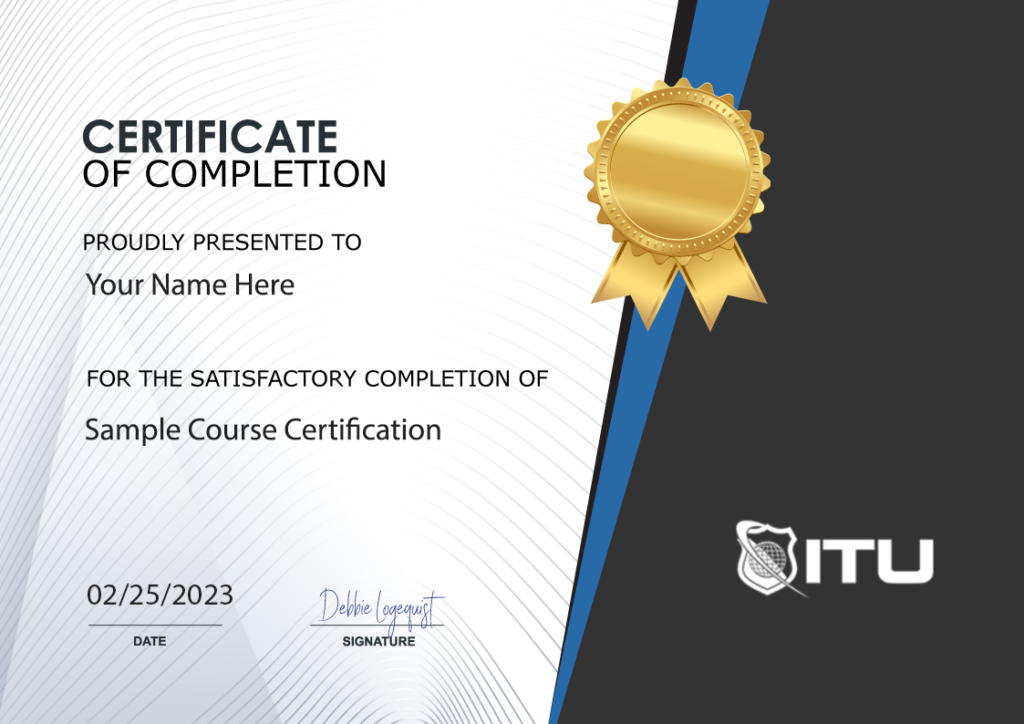Database Admin Bundle
If you want to take your Database Administration career to the next level, then this Database Admin Bundle is for you! Not only does it provide 5 of the most sought-after credentials in DBA, but it also offers an expansive range of courses from SQL to Oracle. Nowhere else can you find a comprehensive package like this that will give your resume and portfolio such an impressive boost!
Included In This Course



Closed Captions



Certificate of Completion
- How to write basic Transact-SQL queries for Microsoft SQL
- The skills to maintain Microsoft SQL Server 2012 databases
- Creating a data warehouse with SQL Server 2012
- Implement ETL with SQL Server Integration Services
- Validate and cleanse data with SQL Server Data Quality Services and SQL Server Master Data Services
Proudly DisplayYour Achievement
Upon completion of your training, you’ll receive a personalized certificate of completion to help validate to others your new skills.
Oracle 12c OCP 1Z0-062: Installation and Administration Course Content
Module 1: Database Concepts And Tools
- Instructor And Course Introduction
- Database Concepts And Tools - Part 1
- Database Concepts And Tools - Part 2
Module 2: Memory Structure
- Memory Structure - Part 1
- Memory Structure - Part 2
Module 3: Tables
- Tables - Part 1
- Tables - Part 2
Module 4: Indexes
- Indexes - Part 1
- Indexes - Part 2
Module 5: Constraints And Triggers
- Constraints And Triggers - Part 1
- Constraints And Triggers - Part 2
Module 6: Users
- Users
- Profiles
- Privileges
- Roles
Module 7: Internal Structures
- Storage Structures - Part 1
- Storage Structures - Part 2
- Internal Memory Structures - Part 1
- Internal Memory Structures - Part 2
- Background Processes - Part 1
- Background Processes - Part 2
Module 8: Starting Up and Shutting Down Database
- Starting And Stopping DataBase - Part 1
- Starting And Stopping DataBase - Part 2
Module 9: Critical Storage Files
- Critical Storage Files - Part 1
- Critical Storage Files - Part 2
Module 10: Data Manipulation Language
- DML Atomicity - Part 1
- DML Atomicity - Part 2
- DML Insert
- DML Update - Part 1
- DML Update - Part 2
- DML Delete And Review Of DML Statements - Part 1
- DML Delete And Review Of DML Statements - Part 2
Module 11: Data Concurrency
- Data Concurrency - Part 1
- Data Concurrency - Part 2
Module 12: BackUp And Recovery
- Back Up - Part 1
- Back Up - Part 2
- Back Up - Part 3
- RMAN Catalog
- RMAN BackUps - Part 1
- RMAN BackUps - Part 2
- Disaster Preparedness
- Recovery
- Flashback Recovery
Module 13: Installation
- Installation - Part 1
- Installation - Part 2
Module 14: Course Review
- Course Review - Part 1
- Course Review - Part 2
- Course Review - Part 3
- Course Review - Part 4
- Course Review - Part 5
- Course Outro
Oracle 12c OCP 1Z0-061: SQL Fundamentals Course Content
Module 1: Introduction To Oracle 12c SQL Fundamentals
- Introduction
- Intro To Oracle 12c-SQL Fundamentals
- Structure Of SQL
- Basic Select Statements
- Basic Select Statements Demo
Module 2: Retrieving Data
- Modifying Reported Output
- The Where Clause
- The Order By Clause
- Left And Right Outer Joins
- The Where Clause Demo
- Multi-Table Selection Demo
Module 3: SQL Functions
- Single Row Functions
- Aggregate Functions
- Single Row Functions Demo
- Muiltrow Functions Demo
- Group By
- Grouping Demo
- Conversion Functions
- Conversion Functions Demo
- Datetime Functions
- Datetime Functions Demo
Module 4: Subqueries
- Single-Row Subqueries
- Single-Row Subqueries Demo
- Multi-Row Subqueries
- Multi-Row Subqueries Demo
- Other Subquery Types
- Other Subquery Types Demo
Module 5: Data Manipulation Language
- Adding Data
- Changing Data
- Deleting Data
- DML Demo
Module 6: Data Control Language
- Security
- Object Privileges
- DCL Demo
Module 7: Data Definition Language
- Creating Objects In The Database
- Creating Objects In The Database Demo
- Sequences
- Sequenced Demo
- Indexes
- Views
Module 8: Combining Queries
- Combining Queries
Module 9: Oracle 12C SQL Fundamentals Review
- Oracle 12c SQL Fundamentals Review - Part 1
- Oracle 12c SQL Fundamentals Review - Part 2
- Oracle 12c SQL Fundamentals Review - Part 3
- Conclusion
Microsoft 70-331: Core Solutions of SharePoint Server 2013 Course Content
Module 1: Comprehensive Introduction to Sharepoint
- Course Intro
- Social Media
- Moblie Access
- Business Intelligence - Part 1
- Business Intelligence - Part 2
- Sharepoint Licensing Overview
- Organize Info
- Share Your Insights
- Minimal Download Strategy
- Enhances Social and Collaboration Features
- Enhanced Search
- Workflow
- Enterprise Content Management
- Web Content Management
Module 2: Installing SharePoint
- What We Will Cover - Part 1
- What We Will Cover - Part 2
- What We Will Cover - Part 3
- What We Will Cover - Part 4
- What We Will Cover - Part 5
- What We Will Cover - Part 6
- What We Will Cover - Part 7
- What We Will Cover - Part 8
- What We Will Cover - Part 9
- Software Requirements
- Service and Accounts
Module 3: SharePoint Architecture, Logical & Physical
- Physical Architecture
- Physical Architecture - Traditional Topologies
- Physical Architecture - Streamlined Topologies
- Physical Architecture - Search Architectures
- Physical Architecture - Enterprise Search Architecture
- Physical Architecture - Multi - Farm
- Logical Architecture
- Logical Architecture - Host Names Based Sites
- Logical Architecture - Path - Based
- Logical Architecture - Extranet
- Logical Architecture - Mobile
- Logical Architecture - Single Farm Deployment
- Databasis
- Summary
Module 4: Web Applications and Site Collections
- Web Applications and Site Collections Intro
- Logical Structure and Web Applications
- Demo
- Site Collections
- Demo - Part 1
- Demo - Part 2
- Application Pools and Summary
Module 5: Configure Service Applications
- Intro
- Service Applications
- Demo of Configuring Excel Services
- Sharepoint Management Shell Demo
- Summary
Module 6: Permissions
- Intro
- Site Permissions
- Terms
- Demo
- Authentication Modes
- O Auth
- Summary
Module 7: Search
- Intro
- Intro to Search
- Search Logical Architecture
- Crawling the Content
- Conent Processing
- Analytics Processing Component
- Summary
Module 8: User Profiles
- Intro
- User Profile Service
- User Profile Demo
- Profile Synchronization Goals
- Profile Synchronization Demo
- Sync Performance Changes
- Sync Performance Changes Demo
- Profile Import Options
Module 9: Ongoing Support and Maintenance
- Intro
- What To Look For
Microsoft 70-332: Advanced Solutions of SharePoint Server 2013 Course Content
Module 1: Business Continuity
- Course Intro
- Intro to Plan Business Continuity Management - Part 1
- Intro to Plan Business Continuity Management - Part 2
- Describe High Availability
- Degraded Availability
- Qualifying Downtime
- Qualifying Downtime Demo - Part 1
- Qualifying Downtime Demo - Part 2
- Qualifying Downtime Demo - Part 3
- Qualifying Downtime Demo - Part 4
- Qualifying Downtime Demo - Part 5
- Qualifying Downtime Demo - Part 6
- Disaster Recovery Plan (DRP) - Part 1
- Disaster Recovery Plan (DRP) - Part 2
- Measure Availability - Part 1
- Measure Availability (Demo) - Part 2
- Measure Availability - Part 3
- Downtime Metrics - Part 1
- Downtime Metrics - Part 2
- Performance to Availability Relationship
- Costs of HA
- HA Supports in a Farm
- Fault Tolerant in your HA Solution
- Backup and Recovery in SharePoint 2013
- Summary
Module 2: Model, Design, and Test
- Intro
- Plan for Success
- Model - Part 1
- Model - Part 2
- Model - Part 3
- Model - Part 4
- Model - Part 5
- Model - Part 6
- Model - Part 7
- Model - Part 8
- Design - Part 1
- Design - Part 2
- Design - Part 3
- Design - Part 4
- Design - Part 5
- Design - Part 6
- Design - Part 7
- Test - Part 1
- Test - Part 2
- Test - Part 3
- Test - Part 4
- Test - Part 5
- Test - Part 6
- Test - Part 7
- Deploy
- Monitor and Maintain
Module 3: Upgrade and Migrate
- Intro to Upgrade and Migrate to SharePoint 2013
- Upgrading to SharePoint 2013 - Part 1
- Upgrading to SharePoint 2013 - Part 2
- Upgrading to SharePoint 2013 - Part 3
- Upgrading to SharePoint 2013 - Part 4
- Upgrading to SharePoint 2013 - Part 5
- Upgrading to SharePoint 2013 - Part 6
- Upgrading to SharePoint 2013 - Part 7
Module 4: Create and Configure Service Applications
- Intro to Create and Configure Service Applications
- Create and Configure Service Applications
- Create and Configure Service Applications Demo
- Create and Configure Service Applications Summary
Module 5: SharePoint Management
- Intro to Manage SharePoint Solution, BI, and System Integration
- Manage SP Solutions, BI, and System Integration
Microsoft 70-461: Querying SQL Server 2012 Course Content
Lesson 1: Getting Started with SQL Server 2012
- Course Introduction
Lesson 2: Working with T-SQL
- Creating Queries-Part 1
- Creating Queries-Part 2
- Creating Queries-Part 3
- Creating Queries-Part 4
- Creating Queries-Part 5
- Constraints-Part 1
- Constraints-Part 2
- Constraints-Part 3
- Constraints-Part 4
- Constraints-Part 5
Lesson 3: Writing SELECT Queries
- Select Statement-Part 1
- Select Statement-Part 2
- Select Statement-Part 3
- Select Statement-Part 4
Lesson 4: Working with SQL Data Types
- Data Types-Part 1
- Data Types-Part 2
- Data Types-Part 3
- Data Types-Part 4
- Data Types-Part 5
- Data Types-Part 6
- Data Types-Part 7
- Data Types-Part 8
- Data Types-Part 9
- Data Types-Part 10
Lesson 5: Sorting and Filtering Data
- Sorting Results-Part 1
- Sorting Results-Part 2
- Sorting Results-Part 3
- Sorting Results-Part 4
- Sorting Results-Part 5
- Sorting Results-Part 6
Lesson 6: Querying Data from Multiple Tables
- Tables Part 1
- Tables Part 2
- Tables Part 3
- Tables Part 4
- Tables Part 5
- Tables Part 6
Lesson 7: Modifying Data
- Inserting Data-Part 1
- Inserting Data-Part 2
- Inserting Data-Part 3
- Inserting Data-Part 4
- Inserting Data-Part 5
- Inserting Data-Part 6
Lesson 8: Working with SQL Server Built-in Functions
- Functions
- Parse
- Logical Functions
- Group By
Lesson 9: Programming in T-SQL
- Programming-Part 1
- Programming-Part 2
- Programming-Part 3
- Programming-Part 4
- Programming-Part 5
- Programming-Part 6
Lesson 10: Implementing Stored Procedures
- Storage Procedures-Part 1
- Storage Procedures-Part 2
- Dynamic SQL-Part 1
- Dynamic SQL-Part 2
Lesson 11: Working with Subqueries and Table Expressions
- Sub-Queries And Table Expressions-Part 1
- Sub-Queries And Table Expressions-Part 2
- Sub-Queries And Table Expressions-Part 3
- Sub-Queries And Table Expressions-Part 4
Lesson 12: Working with Set Operators, Conditional Operators, and Window Functions
- Set Operators-Part 1
- Set Operators-Part 2
- Window Functions-Part 1
- Window Functions-Part 2
- User Defined Functions-Part 1
- User Defined Functions-Part 2
- Advanced Analytical Functions
Lesson 13: Working with PIVOT, UNPIVOT, and Grouping Sets
- Pivot
- Grouping Sets
Lesson 14: Managing Error Handling and Transactions
- Error Handling-Part 1
- Error Handling-Part 2
- Manage Transactions-Part 1
- Manage Transactions-Part 2
- Manage Transactions-Part 3
Lesson 15: Querying SQL Server System
- System Databases-Part 1
- System Databases-Part 2
- System Databases-Part 3
- System Databases-Part 4
Lesson 16: Optimizing Query Performance
- Query Planning-Part 1
- Query Planning-Part 2
- Index-Part 1
- Index-Part 2
- Index-Part 3
Microsoft 70-462: Administering SQL Server 2012 Databases Course Content
Lesson 1: Identifying the SQL Server Platform
- Overview
- DataStorage-Part 1
- DataStorage-Part 2
Lesson 2: Deploying SQL Server
- Install-Part 1
- Install-Part 2
Lesson 3: Configuring SQL Server
- Configuring-Part 1
- Configuring-Part 2
- Changing Memory-Part 1
- Changing Memory-Part 2
- Email-Part 1
- Email-Part 2
Lesson 4: Managing Databases in SQL Server 2012
- User Databases-Part 1
- User Databases-Part 2
- User Databases-Part 3
- User Databases-Part 4
- User Databases-Part 5
Lesson 5: Managing SQL Server Security
- Setting Security-Part 1
- Setting Security-Part 2
- Server Roles-Part 1
- Server Roles-Part 2
- Setting Permissions-Part 1
- Setting Permissions-Part 2
Lesson 6: Implementing Advanced Security Settings
- Querying Data From Multiple Tables-Part 1
- Querying Data From Multiple Tables-Part 2
- Querying Data From Multiple Tables-Part 3
- Querying Data From Multiple Tables-Part 4
- Querying Data From Multiple Tables-Part 5
Lesson 7: Applying Encryption and Compression
- Encrypting And Compressing-Part 1
- Encrypting And Compressing-Part 2
- Encrypting And Compressing-Part 3
Lesson 8: Working with Indexes and Log Files
- Functions-Part 1
- Functions-Part 2
- Functions-Part 3
- Functions-Part 4
- Functions-Part 5
- Functions-Part 6
Lesson 9: Working with Backup and Restore
- Managing Backups-Part 1
- Managing Backups-Part 2
- Managing Backups-Part 3
- Managing Backups-Part 4
- Managing Backups-Part 5
- Managing Backups-Part 6
- Managing Backups-Part 7
Lesson 10: Implementing High Availability
- Stored Procedures-Part 1
- Stored Procedures-Part 2
- Stored Procedures-Part 3
- Stored Procedures-Part 4
Lesson 11: Optimizing Server Performance
- Managing SQL Performance-Part 1
- Managing SQL Performance-Part 2
- Managing SQL Performance-Part 3
- Managing SQL Performance-Part 4
- Managing SQL Performance-Part 5
- Managing SQL Performance-Part 6
- Managing SQL Performance-Part 7
Lesson 12: Troubleshooting Issues and Recovering Databases
- Set Operators-Part 1
- Set Operators-Part 2
- Set Operators-Part 3
- Set Operators-Part 4
- Set Operators-Part 5
Lesson 13: Performing Advanced Database Management Tasks
- Managing Database Infrastructures-Part 1
- Managing Database Infrastructures-Part 2
- Managing Database Infrastructures-Part 3
Microsoft 70-463: Implementing a Data Warehouse with SQL Server 2012 Course Content
Lesson 1: Introduction to Data Warehouse
- Introduction
- Introduction To Data Warehouse-Part1
- Introduction To Data Warehouse-Part2
- Introduction To Data Warehouse-Part3
- Introduction To Data Warehouse-Part4
- Introduction To Data Warehouse-Part5
- Introduction To Data Warehouse-Part6
Lesson 2: Creating Dimensions and Changing Granularity of Dimensions
- Creating Dimensions And Changing Granularity Of Dimensions-Part1
- Creating Dimensions And Changing Granularity Of Dimensions-Part2
- Creating Dimensions And Changing Granularity Of Dimensions-Part3
- Creating Dimensions And Changing Granularity Of Dimensions-Part4
- Creating Dimensions And Changing Granularity Of Dimensions-Part5
- Creating Dimensions And Changing Granularity Of Dimensions-Part6
Lesson 3: Creating Fact Tables and ColumnStore Indexes
- Creating Fact Tables And Column Store Indexes-Part1
- Creating Fact Tables And Column Store Indexes-Part2
- Creating Fact Tables And Column Store Indexes-Part3
- Creating Fact Tables And Column Store Indexes-Part4
- Creating Fact Tables And Column Store Indexes-Part5
Lesson 4: Implementing Data Warehouse in SQL Server 2012
- Implementing Data Warehouse-Part1
- Implementing Data Warehouse-Part2
- Implementing Data Warehouse-Part3
- Implementing Data Warehouse-Part4
Lesson 5: Working with Integration Services
- Working With Integration Services-Part1
- Working With Integration Services-Part2
- Working With Integration Services-Part3
- Working With Integration Services-Part4
- Working With Integration Services-Part5
- Working With Integration Services-Part6
Lesson 6: Managing Control Flow
- Managing Control Flow-Part1
- Managing Control Flow-Part2
- Managing Control Flow-Part3
- Managing Control Flow-Part4
- Managing Control Flow-Part5
Lesson 7: Working with Dynamic Variables
- Working With Dynamic Variables-Part1
- Working With Dynamic Variables-Part2
- Working With Dynamic Variables-Part3
- Working With Dynamic Variables-Part4
- Working With Dynamic Variables-Part5
- Working With Dynamic Variables-Part6
- Working With Dynamic Variables-Part7
- Working With Dynamic Variables-Part8
Lesson 8: Implementing Data Flow
- Implementing DataFlow-Part1
- Implementing DataFlow-Part2
- Implementing DataFlow-Part3
- Implementing DataFlow-Part4
- Implementing DataFlow-Part5
- Implementing DataFlow-Part6
- Implementing DataFlow-Part7
- Implementing DataFlow-Part8
Lesson 9: Managing Data Flow
- Managing DataFlow-Part1
- Managing DataFlow-Part2
- Managing DataFlow-Part3
- Managing DataFlow-Part4
Lesson 10: Managing SSIS Package Execution
- Managing SSIS Package Execution-Part1
- Managing SSIS Package Execution-Part2
- Managing SSIS Package Execution-Part3
- Managing SSIS Package Execution-Part4
- Managing SSIS Package Execution-Part5
- Managing SSIS Package Execution-Part6
Lesson 11: Debugging and Troubleshooting
- Debugging And Troubleshooting-Part1
- Debugging And Troubleshooting-Part2
- Debugging And Troubleshooting-Part3
- Debugging And Troubleshooting-Part4
Lesson 12: Deploying Packages
- Deploying Packages-Part1
- Deploying Packages-Part2
- Deploying Packages-Part3
Lesson 13: Securing Packages and Databases
- Securing Packages And Databases-Part1
- Securing Packages And Databases-Part2
Lesson 14: Working with MDS and Windows
- Working With MDS And Windows Azure
Oracle Database 11g Certified Associate (OCA) Fundamentals 1Z0-051 and Admin 1z0-052 Course Content
Module 1: Database Admininstration
- Intro to Oracle
- Database Administration
- Installing Oracle - Part 1
- Installing Oracle - Part 2
- Post Setup Overview - Part 1
- Post Setup Overview - Part 2
- SQLplus - Part 1
- SQLplus - Part 2
- SQLplus Demo - Part 1
- SQLplus Demo - Part 2
- SQLplus Demo - Part 3
- Startup and Shutdown - Part 1
- Startup and Shutdown - Part 2
Module 2: Oracle Architecture
- Oracle Architecture
- Schema Objects
- Data Access
- Architecture
Module 3: Database Schema
- Database Schema
- Create Table & Tablespace - Part 1
- Create Table & Tablespace - Part 2
- Create View
- Create Index
- Create Sequence
Module 4: Recovery Manager
- Recovery Manager
- What is RMAN
- RMAN Demo
- Restore - Part 1
- Restore - Part 2
Module 5: Introduction to SQL
- SQL - Part 1
- SQL - Part 2
- Parts of SQL Statement
- Select Statement
Module 6: Filtering and Sorting Data
- Build ERD - Part 1
- Build ERD - Part 2
- Build ERD - Part 3
Module 7: Functions
- Functions
- More Functions
- Group Functions
- Custom Functions
Module 8: SET Operators and Subqueries
- SET Operations
- Subqueries
Module 9: Regular Expressions and SQL Loader
- Regular Expressions
- SQL Loader
| 5 star | 82 | 82% |
| 4 star | 17 | 17% |
| 3 star | 1 | 1% |
| 2 star | 0% | |
| 1 star | 0% |
Sorry, no reviews match your current selections
Your Training Instructors
Chrys Thorsen is an education and technology expert who specializes in enterprise-level IT infrastructure consulting and certified training-of-trainers. In her career, she has garnered over 50 IT Certifications including CISSP, CISA, CEHv12, PenTest+, CompTIA CNVP, Cisco CCSI/CCNP, Microsoft Cloud and on-premises technologies, VMware vSphere, and many more. She has also authored 40 published certification textbooks, and over 35 full-length IT certification video courses.
When not working in the United States, Chrys spends her time abroad capacity-building IT literacy in developing nations in Sub-Saharan Africa. Her client list has included: the US Federal Government, the Republic of Zambia Ministry of Health, Cavendish University Zambia, Accenture, JP Morgan Chase, the US Centers for Disease Control and Prevention, the Elizabeth Glaser Pediatric AIDS Foundation (EGPAF), Hughes Aircraft, Microsoft, and many more.
Chrys lives by, and is fond of repeating, her professional creed:
“The only true measure of success for any project or training is results on the ground. Everything else is just noise.” “I teach what I deploy; I deploy what I teach.”
Rafiq has extensive experience including more than 20 years in IT as a Systems Architect, Software Engineer, DBA, and Project Manager. He has instructed in a variety of technical areas and has designed and implemented network and information systems. Bringing nearly 30 years of advanced IT experience to each course and adding his unique perspective and “real world” tips, Rafiq has a knack for making complex topics easy to understand.

Subscribe To All-Access
Lock In $16.99 / Month Forever
Access this course and over 3,000 hours of focused IT training. Start your first month for only $1.00. Then lock in only $16.99 / month for life.
- Get Every Course
- Free Updates / New Content Added
- 3,000+ Hours of Training
- Price Lock Guarantee
- Games / Flashcards
- 21,000+ Practice Questions
$49.99 $16.99 Monthly
$49.00





good
Smooth delivery and easy access to LMS. Good to see that the LMS offers progress tracking. Would be great if badges were offered on completion of courses to share via Credly to future employers.